ServiceNow CMDB Implementation Aligned with CSDM 3.0
ServiceNow CMDB Implementation Aligned with CSDM 3.0
Ketan Shah, Senior Solutions Consultant
Digital Transformation is seldom understood at a level necessary to create meaningful business outcomes. The ServiceNow CMDB is a centralized store of information in a relational model critical to driving workflows that have undergone digital transformation. For years customers have struggled with implementing and maintaining a CMDB. Much of the documentation and practice for attempting it was driven out of academic frameworks surrounding the larger configuration management discipline and how it underpins successful service management. Lost in the academic references were translations to business value and how to achieve meaningful digital transformation that leads to service automation and the velocities necessary to gain competitive advantage is today’s business landscape.
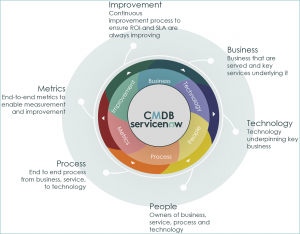
To help our customers achieve these critical business capabilities we need to turn the focus away from industry frameworks and have the focus centered on what data elements are necessary to derive business value for the customer. And, how do they implement and maintain those elements in a ServiceNow CMDB implementation? If the customer has multiple desired outcomes, in which order should the data elements be implemented? What can be done concurrently and what should be done linear? We need to be conscious of the fact that it is not only the “how” of the initial implementation of those data elements but the on-going data management and governance processes that will lead to the ongoing success necessary to continue to drive business value.
Much of the value of the ServiceNow platform lies in the ability to create workflows that support the design, implementation and operation of our key business capabilities. These business capabilities should be expressed via a product and services-oriented taxonomy that seeks to connect the logical constructs to the underlying technological infrastructure and have them be consumable both internally and externally via various forms of Service Offerings. ServiceNow’s Common Services Data Model is the realization of that product and services-oriented taxonomy. Customers will need to come to an understanding of what products and services are utilized when, across various scenarios, and implement these logical CIs earlier in the journey in order to drive proper alignment of other workflows to this product and services-oriented taxonomy.
ServiceNow Common Services Data Model (CSDM) is a standardized and shared set of service-related definitions that describe different elements of the service, shared across ServiceNow’s products and platform. The same set of standard service-related definitions spans across the ServiceNow suite of applications and are aligned with the different business units within your organization. It provides a common way to relate to services and derive service reporting. The data model element addresses the way ServiceNow stores and references the common service-related definitions in the CMDB.
This means there is a standard structure, standard attributes and a standard set of relationships.
The importance here is that the application suite, like ITSM, ITBM, CSM, ITOM, and APM, will store information in the right tables and in the right attribute fields.
The data model sets the standard to ensure service-related information can be used appropriately and can be connected in the right way across the platform.
The common services data model really enables the ServiceNow platform to be used as a central source for establishing a seamless picture of services, where information is collated and related to the work performed.
A configuration item (CI) is any component or other service asset that needs to be managed in order to provide an IT service. The goal of Configuration Management is to support efficient and effective service management processes by providing accurate configuration information, aligned to services, to enable people to make the right decisions at the right time.
ServiceNow Configuration Management enables building of logical representations of assets, services, and the relationships between them that comprise the infrastructure. Details about these components are stored in the configuration management database (CMDB) which you can use to monitor the infrastructure, helping ensure integrity, stability, and continuous service operation. Below listed are few key features:
- Baseline CMDB - CMDB baseline provides capabilities that help you to understand and control the changes that have been made to your configuration items.
- CMDB Health – Monitoring and maintaining the health of the CMDB is essential to an effective and continuous use of the product. Health indicators such as duplicate CIs, required CI fields, and audits contribute to the calculation of health scorecards at the CI, class, and CMDB level.
- CI Lifecycle Management - From the time of its creation to the time that it is no longer needed, a CMDB CI would typically transition through several operational states while undergoing various operations. CI Lifecycle Management provides the mechanism to define states and actions for a CI and lets you apply appropriate actions based on a CI's state to tailor the management of CI lifecycle to business needs.
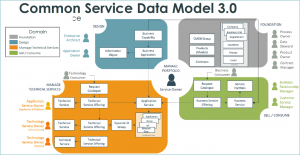
CSDM Domains are groupings of the data model that support activity within the Now Platform. CSDM has 4 Domains: Foundation, Design, Manage Technical Services, and Sell/Consume. Each of these Domains include one or more products within ServiceNow. The combination of quality data across these Domains assist in the day-to-day efforts to achieve business outcomes.
Foundation Domain is a CSDM Domain that represents those tables that contain base data referenced from or to objects in the remaining CSDM domains. The tables identified in the Foundation Domain are not used in CMDB relationships. Instead, they are critical referential data. In some scenarios Foundation data is required prior to the implementation of ServiceNow products and/or buildout of the CMDB. The Business Process table is a CMDB table while the remaining tables exist outside of the CMDB. All tables identified in the Foundation Domain have been available out of the box since prior to the Kingston release of ServiceNow. Common personas in this domain are Process Owner, Data Steward, Product Owner, and Contract Manager.
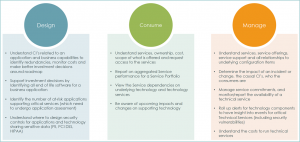
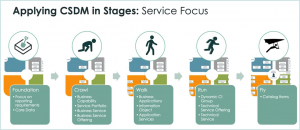
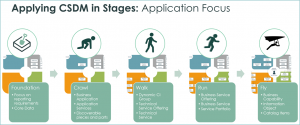
If you are interested in CMDB solution or would like additional information on our ServiceNow Services, please contact us today.
CONTACT US TODAY
